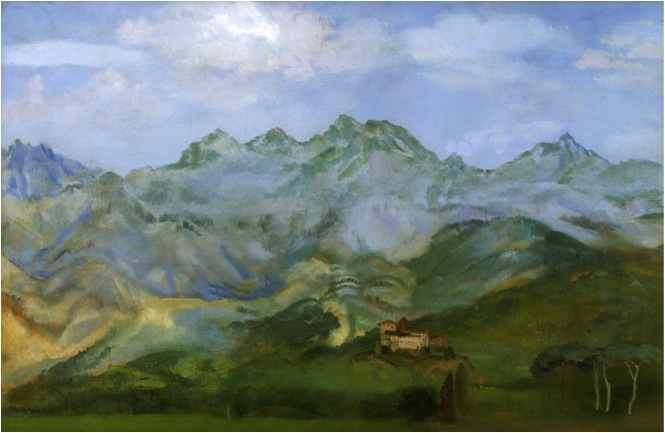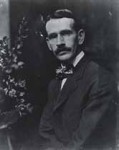
Arthur B. Davies
American, 1862-1928
Italian Landscape, 1925 ca.
oil on paper mounted on board
26 × 40 in.
Gift of Wright S. Ludington
1956.15

Undated photo of Davies
“Art is nature seen through the prism of an emotion . . .” - Arthur B. Davies
RESEARCH PAPER
During most of his lifetime, Arthur B. Davies was one of the most esteemed artists in America. However, shortly after his death his artistic reputation began a sharp decline from which it has not yet recovered. Complicating the problem of arriving at some kind of accurate appraisal of Davies’ role as a painter in art history is the undeniably important part he played in the famous Armory Show of 1913, which introduced modern art to America on a large scale. Unfortunately, for most modern scholars and critics, Davies is remembered mostly for the part he played, as Director of the Show.
He developed as a painter during one of the richest and most complex periods in the history of American and European art and his works share the interest of those times. He was an experimenter whose talent includes oil paintings, bronzes, pastels, watercolors, drawings, prints, carvings in wood and alabaster, tapestries and works in glass, enamel and terra-cotta.
Any close look at Davies’ life and work involves several problems. Firstly, some significant facts concerning his life were either unknown or omitted by most critics and historians who wrote about him before the 1960’s. This was probably due to the secret life he led.
A second problem involves the chronology of Davies’ work; it is unfortunately full of contradictions. Not only did Davies fail to date most of his paintings, but after his death, his widow, who had not lived with him on a regular basis for over a quarter of a century, assigned dates to a number of pictures; many of these dates have since been proven incorrect. To further complicate the problem of establishing chronology, it appears that Davies often reworked his pictures.
Arthur B. Davies was born on September 26, 1862 in Utica, New York. In 1877 at the age of fifteen, he began his first formal study of art under the direction of Dwight Williams. In 1878 Davies moved to Chicago with his family and continued his studies at the Chicago Academy of Design. In 1880 he accompanied an expedition to Mexico as a drafting engineer. He returned to Chicago in 1882, remained for four years and then moved to New York where he studied at the Art Students’ League and worked as an illustrator for Century Magazine and St. Nicholas. In 1892, Davies married Dr. Virginia Meriwether. They moved to Congers, New York and had two sons; Niles and A. David. The marriage was not a happy one however.
By 1905 Davies was no longer living with his family, but lived in New York City with a woman named Edna Potter. For this new life, he adopted the pseudonym of David A. Owen, and in 1912 fathered a daughter by Edna named Ronnie Owen. This second identity was a well-kept secret. Only Walt Kuhn, a close friend of Davies, knew of his second family. Astonishingly, Ronnie never realized that her father was Arthur B. Davies, the artist, until after his death.
In the study of Davies’ style it is impossible to ignore certain elements, such as the discipline which made him, among other things, an extraordinarily sound craftsman. He creates a mood of romantic tenderness. Art was with Davies, a mode of "Conversing with Paradise". And what chiefly passes from his imagination onto the canvas is a sort of "celestial music". What it expresses, far more than any concrete thought, is just his life-long love for beauty.
Davies grasped in a big way the topography of a country and planned a picture of it with the emphasis on space, on linear boundaries, on light and on mystical suggestions. His landscapes are hazy and indistinct. His work reveals the influence of European artists as varied as Giorgione, Pierre Puvis de Chavannes and Arnold Böcklin.
Figures as well as the landscape as a whole, possess the quality of life and that uplift which results from what Davies termed inhalation of air; in other words, the Lift of Inhalation, the deep-seated and innermost secret of the art of Egyptians, The East Indians, and of the Greeks. This theory can be explained as the intake of air in the human body, the swelling upwards, the moment when breath is inhaled. But it was not confined only to the human body. It can be expressed in the clouds as well as in the clear sky, in the waves as well as in the calm surface, in the sandy beach as well as in the cliffs, in the single blade of grass as well as in towering trees and in all the animal world up to and including man. There is some speculation, however, as to whether Davies was successful in expressing this breathing quality in his paintings.
The SBMA painting shows a small cluster of buildings perched around a hill in the lower right. All around are green and golden mountains seen from a high vantage point. Wisps of blue (clouds or fog) partly cover the higher mountains. A blue sky with white clouds is above the rugged green and blue peaks of the mountains. Davies did many watercolors of the Italian landscape from 1924 until his death in 1928. This oil is a reflection of his watercolor technique. This painting may have been titled "Mountains in Springtime" at one time. The reverse side of the canvas indicates this.
Prepared for the Santa Barbara Docent Council by Barbara Ruediger, 11/82
Bibliography
Books
Braigell, Matthew, Dictionary of American Art, 1979
Icon Edition- Harper & Row, Publishers, 10 E. 53rd St., New York, N.Y.
Braigell, Matthew, A History of American Painting, 1971
Praeger Publishers, Inc., 11 Fourth Ave., New York, N.Y.
Cortissoz, Royal, Arthur B. Davies, American Artists Series
Whitney Museum of American Art, 10 w. Eighth St., New York, N.Y.
Arthur B. Davies, Essays on the Man and his Art, No. 3 1924
The Phillips Publication- The Phillips Memorial Gallery
The Riverside Press, Cambridge, Mass.
Essays by Dwight Williams, Frank Jewett Mather, Jr., Gustavus A. Eisen
Catalogs
Tucson Art Center Catalog of Arthur B. Davies
Worcester Art Museum Bulletin- Vol. 6, No. 1- Nov. 1976
SBMA CURATORIAL LABELS
History has not been kind to Davies, despite the fact that he was considered one of the most influential progressive artists in New York and instrumental to the organization of the legendary Armory show in 1913, in which Marcel Duchamp’s Nude Descending a Staircase made its debut. Stylistically, Davies alternated between a soft realism in his early landscapes and a Symbolist inflected, dream-like figuration, reminiscent of the classically informed pastorals of Puvis de Chavannes. This painting comes from a group of works that he produced while convalescing in Florence, which he frequented to relax after having been diagnosed with a heart condition in the early 1920s. It was a gift from our founder, Wright Ludington, who was known for his support of cutting-edge contemporary art.
- Highlights of American Art, 2020
